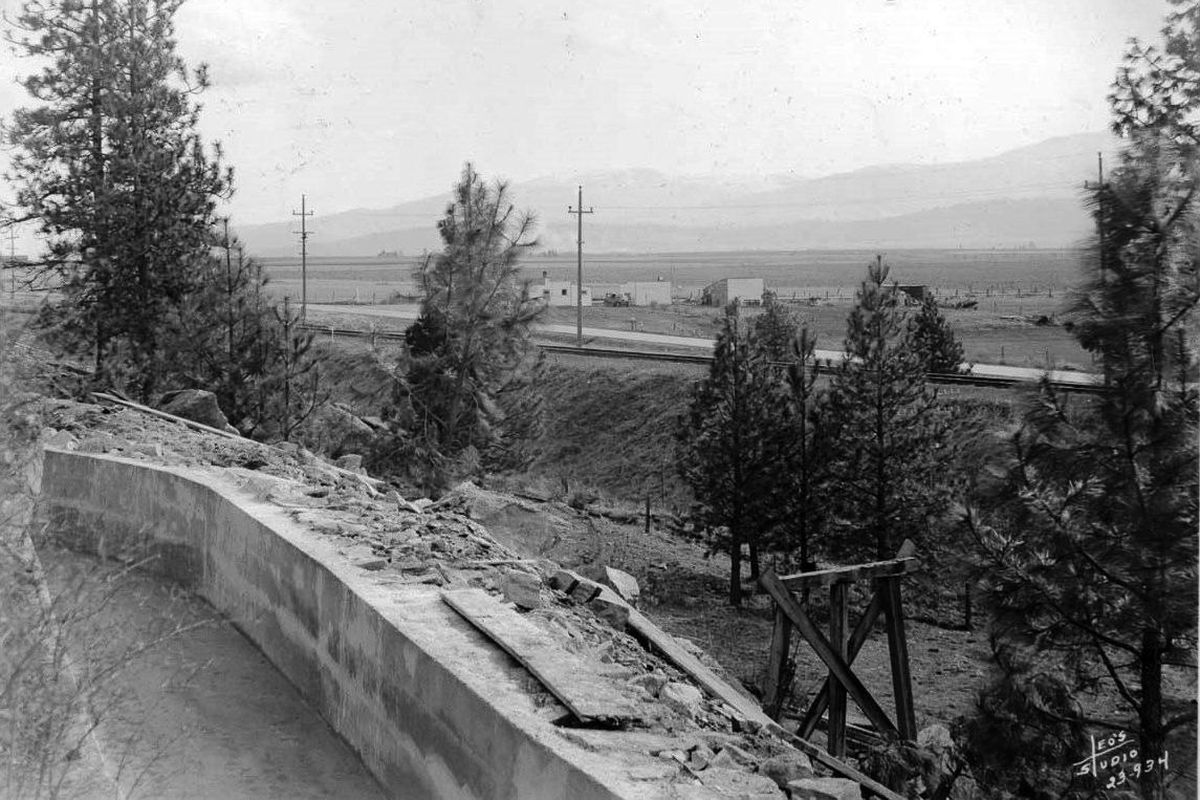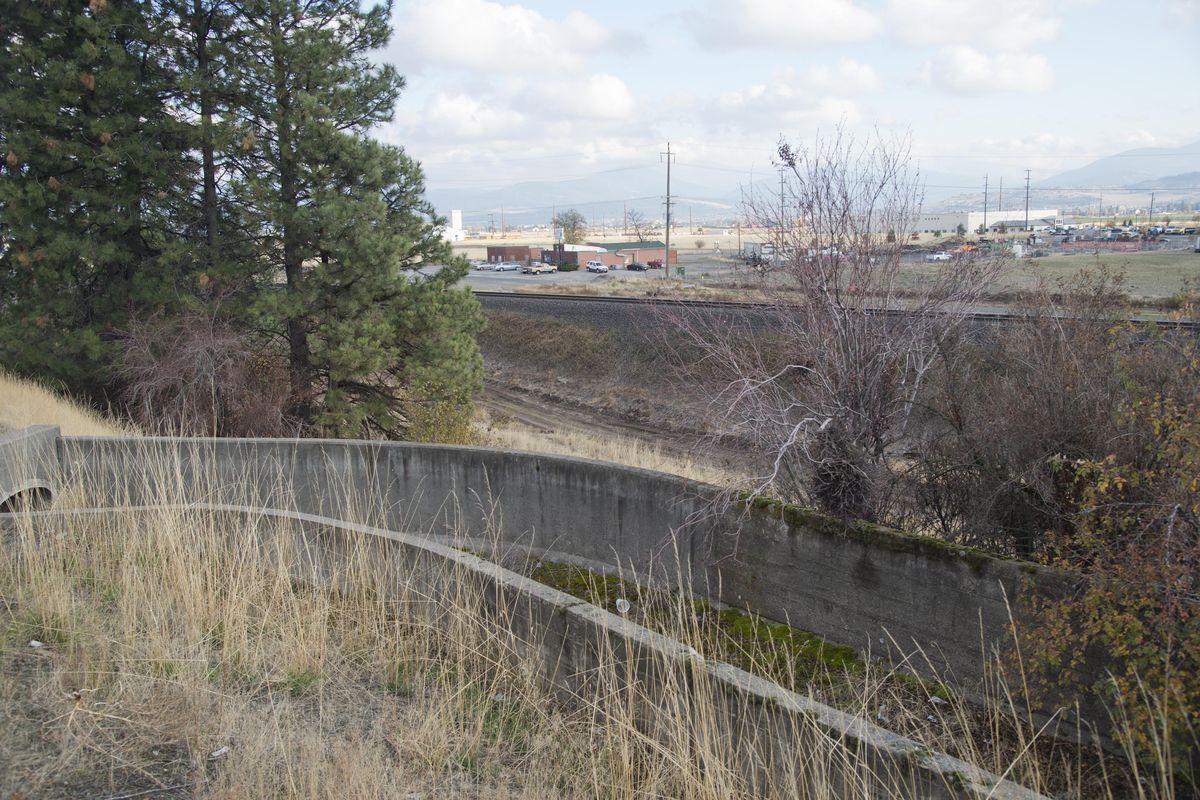Spokane Valley takes tentative steps toward historic preservation
Spokane Valley irrigation structure, 1920s photo (Spokane Museum / The Spokesman-Review)
On an otherwise ordinary Wednesday morning in November last year, phones began ringing across Spokane Valley, at City Hall and in the Spokane Valley Heritage Museum: Bulldozers were moving in and tearing down the Old Plantation, a restaurant and Valley landmark on the corner of Vista Road and Sprague Avenue.
People were outraged that the stone building constructed in the 1930s was being leveled.
Even owner David Birge felt bad, but he couldn’t find a tenant for the quirky old building. Birge said it would have cost about $250,000 to bring the building up to code and make it ready for a business. He held on to the property for two years before deciding to tear it down.
More than 100 comments were posted to the Facebook group called The History of Spokane Valley-1960 to Present, as well as new and old photos and personal memories from the Plantation. The demolition clearly hit a nerve.
Jayne Singleton, executive director of the Spokane Valley Heritage Museum, was shocked when she heard the news.
“I couldn’t believe it. People couldn’t believe it,” Singleton said. “But there was nothing that could be done.”
Spokane Valley does not have a historic preservation ordinance and does not offer any incentives to property owners who take on the often daunting task of restoring an old building.
At the Valley Heritage Museum, volunteers have compiled a database of 131 properties considered historically significant. Some of those properties – like the Old Plantation – no longer exist.
The museum covers an area larger than the city of Spokane Valley: from Rockford to the south to Peone Prairie on the north, Havana Street to the west and a bit into Idaho to the east.
Most of the properties listed in the database are older than 50 years, but Singleton said there are no strict guidelines.
“We look at what happened at the property and what that means to the community,” Singleton said.
The museum relies on the goodwill of property owners when it comes to taking pictures of a building before it’s torn down, or preserving bits and pieces of a structure that’s scheduled for demolition.
In the case of the Old Plantation, nothing was preserved.
The first business on that site was Art Warsinski’s Evergreen Fur Farms, which opened in 1911. In the late 1920s, Warsinski turned the fur farm into the Evergreen Zoo, providing a home for animals that had lived in the zoo in Manito Park. The old animal cages in the back were the only thing left after the building was gone.
In an effort to avoid a repeat of the Old Plantation, Singleton often talks to property owners about the significance of their buildings even if they have no demolition plans. She wants to make certain they remember the museum if they decide to level a building.
“We have been collecting, protecting and preserving the history of the Valley for the last 15 years,” Singleton said. “Having a historic preservation ordinance would certainly help us.”
Ordinance would create voluntary program
Spokane Valley is considering a historic preservation ordinance that would honor and recognize buildings meeting certain historical standards, but would not prevent owners from tearing them down. It’s a voluntary program.
“People are confused about historic preservation ordinances,” said Larry Cebula, professor of history at Eastern Washington University.
“They offer some tax advantages to the owners of historic property, but don’t tie their hands. If they alter the building too much it won’t fit the register anymore.”
Gloria Mantz is a development engineer with Spokane Valley who has been spearheading the research for the ordinance, which has been presented to the City Council.
Mantz said three things have to happen before an ordinance could go into effect in Spokane Valley:
- The historic preservation ordinance has to be written and defined, a process that includes going before the City Council on Dec. 1, then if approved, going before the planning commission, then back to the council.
- The mayor must appoint a historic preservation commission.
- The program would have to be certified by the Washington state Department of Archaeology.
“We would decide which buildings would qualify for the register,” Mantz said, adding that Valley buildings already on the federal and state historic registers are not protected from demolition.
A sticking point for the Spokane Valley City Council is how a historic preservation ordinance would affect property owners. Mayor Dean Grafos has spoken in favor of the historic preservation ordinance, which he called “an economic development tool,” but other council members aren’t so certain. Both Ed Pace and Chuck Hafner have reservations for different reasons: Pace doesn’t want to infringe on the rights of property owners and is uncomfortable with the tax incentives. Hafner doesn’t want the ordinance to get in the way of business development and often refers to the problems Larry H. Miller Group of Companies encountered when trying to expand in downtown Spokane.
Mantz is optimistic that the Valley can write an ordinance that would not cause problems for property owners, but make it more attractive to someone to renovate an old building.
“The program is completely voluntary,” Mantz said. “We will not let you be in the register unless you sign a permission that shows you understand what the registry does.”
Also, only the property owner can nominate a property.
“You can’t just nominate someone else’s house,” Mantz said.
The historic preservation ordinance would offer a tax incentive to owners of buildings on the registry. To get the tax discount, Mantz explained, a building must first be on the register, and the owner must get the proposed restoration or rehabilitation work approved by the historic preservation commission.
Then, once the work is done and the building appreciates in value, the owner will get a tax discount on the difference between the lower appraisal before the restoration work and the higher appraisal after.
In the case of the Old Plantation, for instance, that may have been enough of an incentive to get the owner to invest in restoring the building instead of tearing it down.
Mantz said she has heard from a couple of property owners in Spokane Valley who are interested in and supportive of the historic preservation ordinance.
Given the various hurdles ahead, “If it happens it will be sometime next year,” Mantz said. “It’s up to the City Council and we just don’t know which way it’s going to go.”
‘Historic’ is in the eye of the beholder
Spokane Valley was settled by farmers and fruit growers who covered the area with small farms and irrigated the land with water from the river. Some also built homes and foundations out of round river rock, an architectural detail seen mostly in Spokane Valley.
Old farmhouses and the occasional log cabin can still be spotted among the city’s subdivisions, apartments and strip malls.
Among them is the Courchaine House, at 4011 S. Linke Road, which was built by farmer Daniel Courchaine in 1877. It’s outside Spokane Valley proper but is so old it was built on land purchased from the Coeur d’Alene Tribe.
Closer in, the Van Marter House at 322 N. University Road was built in 1908 by Henry Van Marter, who owned one of the first orchards in the area. It’s a classic two-story home with stone walls and a bit of gingerbread decoration. According to Spokane County documents, Valley residents once roller-skated on the top floor.
Singleton shook her head at people who say the Valley is all strip malls with nothing to preserve.
“They just haven’t been out here,” she said.
But what feels historic to one person may not resonate with another. People who responded to a Spokesman-Review Facebook query on which Valley properties should be preserved suggested private homes, schools, businesses and places where famous people allegedly lived.
Cebula, at Eastern Washington University, said a historical site gives people an emotional or intellectual connection to the past.
“What resonates with people in Spokane Valley may not be the story of Antoine Plante and his ferry crossing, but the shopping mall where they went when they were young,” Cebula said. “History is not just about wars and presidents.”
He added that one way to identify historical sites is to look for different layers of history: very old, not so old and relatively new.
“In the Valley you have the hotels and gas stations that grew up along the old U.S. Highway 10 and the malls of the 1960s,” Cebula said, “and you have the horse slaughter that was done to the natives.”
There are also old buildings that are now in new use, like the home of Deja Vu Showgirls, which used to be the Dishman Theatre, an art deco gem.
“That building kind of shows how the neighborhood has changed,” Cebula said. “That’s also history.”
Some, like the Dishman Train Depot, which is now a fruit stand, are barely recognizable.
Cebula said that what stops people from tearing down buildings is usually public outcry. The Jensen-Byrd Building on WSU’s campus in Spokane is a good example of that, he said.
“When people got upset about it, WSU blinked and stepped back and said, ‘Wait a minute,’” Cebula said, “and they kept the building.”
Sometimes private investors purchase a building in order to preserve it.
“I think that happened to Steve Jobs’ garage, where he built his first computers,” Cebula said. “But it’s rare.”
If Spokane Valley adopts a historic preservation ordinance, city staff would require training to implement it, Mantz said. Spokane Valley could also decide to pursue an interlocal agreement with the Spokane City-County Historic Preservation Office.
“There’s a lot of behind-the-scenes stuff we need to take care of,” Mantz said.
Still, she feels it’s worth it.
“I think people like the old buildings because they give us a sense of identity,” Mantz said. “And without it (an ordinance) we don’t even know what treasures we have here.”
What would you like to preserve in Spokane Valley? Send an email and a photo of the property to piah@spokesman.com.









